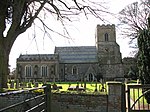Runcton Holme
Civil parishes in NorfolkKing's Lynn and West NorfolkNorfolk geography stubsVillages in Norfolk

Runcton Holme is a village and civil parish in the English county of Norfolk. It covers an area of 13.89 km2 (5.36 sq mi) and had a population of 676 in 288 households at the 2001 census, the population reducing to 657 at the 2011 census. For the purposes of local government, it falls within the district of King's Lynn and West Norfolk. The civil parish includes South Runcton. The villages name means 'Pole farm/settlement on an island', perhaps denoting a trackway or an enclosed settlement. The parish church of St James, Runcton Holme, is a Grade I listed building. St Andrew's in South Runcton is Grade II*.
Excerpt from the Wikipedia article Runcton Holme (License: CC BY-SA 3.0, Authors, Images).Runcton Holme
Banyards Place, King's Lynn and West Norfolk Runcton Holme
Geographical coordinates (GPS) Address Nearby Places Show on map
Geographical coordinates (GPS)
| Latitude | Longitude |
|---|---|
| N 52.65452 ° | E 0.392075 ° |
Address
Banyards Place
Banyards Place
PE33 0AL King's Lynn and West Norfolk, Runcton Holme
England, United Kingdom
Open on Google Maps










